Paging is managing a memory scheme that will remove the need for contiguous allocation of physical memory. The process of retrieving memory in the form of pages from the subordinate storage into the main memory is known as Paging. Paging is used to separate each procedure into pages. Apart from this, frames are used to split the main memory. So, the scheme will help the physical address space of a process to be non-contagious.
The physical memory is categorized into fixed-size blocks called page frames in Paging. These are the same in size as the pages used by the process. Process logical address is divided into fixed-size blocks called pages. Again, these are also the same in size. So, is there any application for requesting memory? In that case, the operating system allows one or more page frames to the process and maps the process logical pages to the physical page frames.
The page table separates and maps the logical pages and physical page frames. The memory management unit uses it to translate logical addresses into physical addresses. The page tab will map each rational page number to a physical frame number.
Benefits of Paging
- The memory is divided into fixed-size blocks called pages. Similarly, the physical memory is divided into blocks of the same size, known as page frames.
- The operating system maintains a data structure called a page table. This table keeps track of the mapping between virtual pages and physical page frames. Each entry in the page table holds the mapping information for a particular virtual page.
- A page fault will happen when a process accesses a virtual page not currently in physical memory. The operating system must then bring the required page into physical memory from the disk.
Conclusion
In conclusion, Paging is used to separate each procedure into pages. Apart from this, frames are used to split the main memory. So, the scheme will help the physical address space of a process to be non-contagious.

